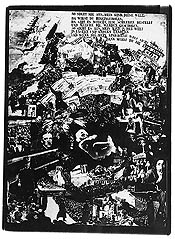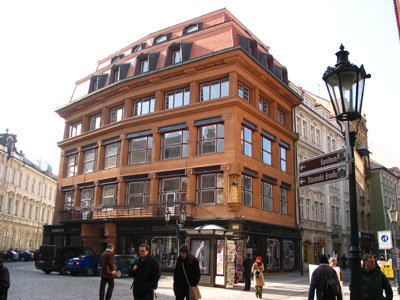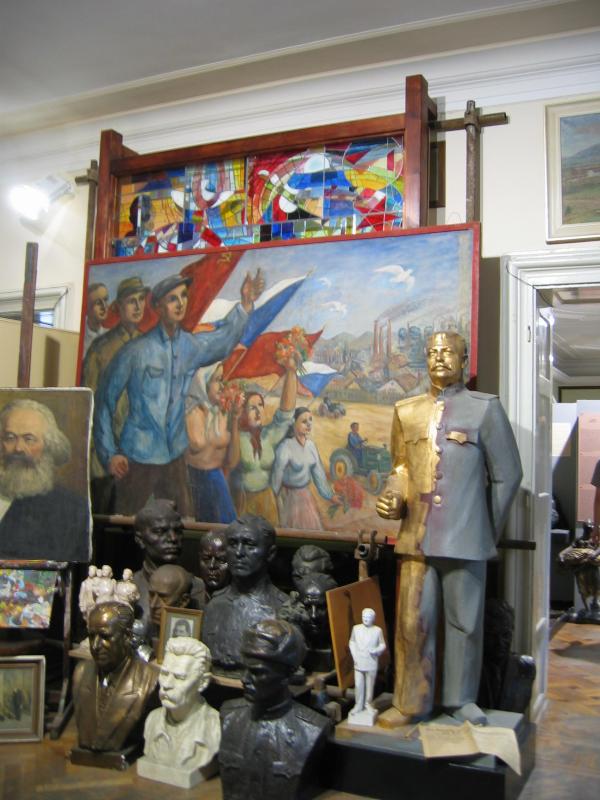I had debated whether I should revisit Terezin (Theresienstadt) since I had gone there last year and seen most of it, but in the end, I figured I had to go, if only to time how long each segment would be with students. Having just gotten back, however, I'm now quite glad I did.
It was a short one-hour bus trip to Terezin. I got to the bus five minutes before departure and groaned when I saw how long the line was to board, and that all the seats were already taken. Luckily, I still got on, but spent the hour swaying back and forth while standing.
The museum and the exhibits have not noticeably changed from last year. I found myself paying more attention this time to the efforts of the children to create their own newspaper in the ghetto (called "Vedem"). The boys who founded it lived in the building that currently houses the main museum. The museum was much less crowded this time, and I was able to see the main exhibits in about an hour. I decided to skip the film (which I've already seen) and walk over the Madgeburg Barracks after a quick lunch.
The Magdeburg Barracks are devoted mostly to the artistic and literary productions of the prisoners in the ghetto. They have recreated one of the living sections to give visitors a sense of what it was like when crammed, literally, to the rafters, but the camera police were in full force, so no photos. In their absence, I've downloaded this poorer image off the internet:

[recreation of women's quarters in Madgeburg Barracks]
Down the hall is a room on composers who were imprisoned in the ghetto, including a display on Brundibar, the children's opera performed in the ghetto. Here's a copy of one of the posters that hung in the ghetto:

["Brundibar" -- composed by Hans Krasa]
If you want to hear the music, by the way, you need to ask one of the "wardens" whose job is to prevent people from taking pictures. They just flip a switch and you can hear excerpts from music composed in the ghetto.
Then there are several rooms of art done by prisoners in the ghetto. Many of these works were prepared in secret to document the real conditions in the "model" "old age home." Here's an example to give you a sense of what this art looks like:

[Leo Haas: "The Arrival of the Children from Bialystok" (1943)]
Several of these artists tried to smuggle their sketches to the visiting team from the International Red Cross in 1944, but the Red Cross guests were wholly taken in by the Germans, and the artists were arrested and charged with distributing "propaganda of horror." Most were either murdered in the Small Fortress or died later in Auschwitz. Haas was one of the few who survived.
I did manage to get one snap shot of a stage set in a room devoted to theater productions in the ghetto (the wardens were off at the time, though one came rushing up 20 seconds later -- I guess she heard the camera shutter, I just acted like nothing had happened). I wanted to buy the video of a performance of "Brundibar," but all the DVDs were in PAL format, which doesn't work in America.
After about a half an hour, I headed towards the Small Fortress, which I had only partially visited the last time. On the way there, I checked out the cemetery to see if there had been any changes to the way the memorial was constructed. The plinths on which writing had originally been affixed are still bare, but I noticed this time that the sign "National Cemetery," still is on the front.

[The Star of David, which was added since the 1989. When the cemetery was constructed, between 1945 and 1954, it was marked only with a large wooden cross, which still stands in the middle of what is almost entirely a Jewish cemetery]
I skipped the museum exhibit on the history of the Small Fortress and the Theresienstadt construction, as I'd seen that the last time. Instead, I took the walking tour of what is essentially a nineteenth-century prison facility. At one point, the path goes through a half kilometer-long "connecting corridor," which traces the original fortifications of the structure. That's about a quarter mile of a narrow, low-roofed tunnel, lit either by bulbs or by small, very narrow windows. Every time I thought I'd reached the end, the exit was barred by a locked gate, and I had to continue further into the tunnel. Finally, I reached the point where the light at the end of the tunnel actually led to an open door and I could finally exit.
This was at the site of the execution grounds within the Small Fort. Again, the place was marked by the concrete outlines of three crosses on the ground, in a place where 90% of the people killed were Jewish. After that the path led back into the Fort, where I had the opportunity to watch a short video form 1965, mostly based on the propaganda films shot by the Germans. It ended, however, with the "El Malei Rachamim" prayer for victims of the Holocaust, and in that time and place, it brought me suddenly to tears.
I was getting ready to head back and only had one last area to visit, when I suddenly noticed a group of about half a dozen Czech men, all but two with shaved heads, who were wearing combat-style fatigue pants, coming into the exhibit room. At least two had t-shirts with the word "hate" printed on them (as part of phrases I couldn't quite make out), while a third had on a black t-shirt which had two guns in red on the front and something about before the last war written on it. Although I can't be sure, as I don't speak Czech, I think they were neo-Nazis or Czech skinheads. I didn't want to get too close (one had what looked like a shiv attached to his belt), but they were clustered around a display on Nazi officers who had served at a Nazi forced labor facility a few miles away.
I was surprised to see Czechs embracing a group that had occupied and enslaved their own country, but I suppose that just as a small number of victims of abuse come to identify with their abusers and become perpetrators themselves, perhaps it could also be true of peoples.
I left and headed back to the main ghetto, stopping off to see the memorial to where the ashes of those who had died in the ghetto and had then been cremated were dumped in the Ohre River. This is another one of those communist-era monuments where there is nothing Jewish-specific at the site.
It got me thinking about the research paper I'm working on concerning post-communist holocaust memorializations. I think of it now as a series of layers building on top of one another. At the bottom, the first layer, are the memorials created by the communists prior to 1989 (though even within this group, there are subtle differences). In most cases, the Jewish specificity of the victims are elided in favor of a more generic "victims of Nazi persecution."
The next layer are those modifications or additions added or made by the state since 1989. In some cases this meant taking away problematic texts or amending them. In other cases, as with the Small Fortress cemetery, it meant adding Jewish symbols to an existing memorial.
The third layer are new memorials created by the state in places where there were none previously, posing the problem of how local collaboration with the Nazis should or should not be depicted.
Finally, there is the top most layer, which are memorials or symbols created by Jews and/or Jewish organizations.
I saw several of these at the Columbarium. To the right of the entrance is the old communist-era memorial, with its generic reference to "25,000 persons" who died in the ghetto (in Czech, Russian, German, English, and French). Then inside is the new text which is much more Jewish specific. Finally, the walls are lined with plaques added by German and Austrian cities, from whence Jews had been sent, as well as smaller plaques put up by individual Jewish families.
After that I was ready to head back. There was only one last bus, which came at 3:43 pm. A group of 20 German students were waiting, along with a dozen others, and almost every seat on the bus was taken before it arrived. I managed to get on, and get the last seat. Since it was the last bus of the day, the driver kept stopping and trying to find ways of shoving in more passengers. I thought the bus would plotz before we ever reached Prague. Proof, if I ever needed any, that if I take student here, I will need to rent a bus.
Anyway, there are to hotel guests waiting to use the computer, so I will sign off for now. Tonight it's back to my favorite restaurant in Malastranka and then tomorrow I head for Vienna.















































